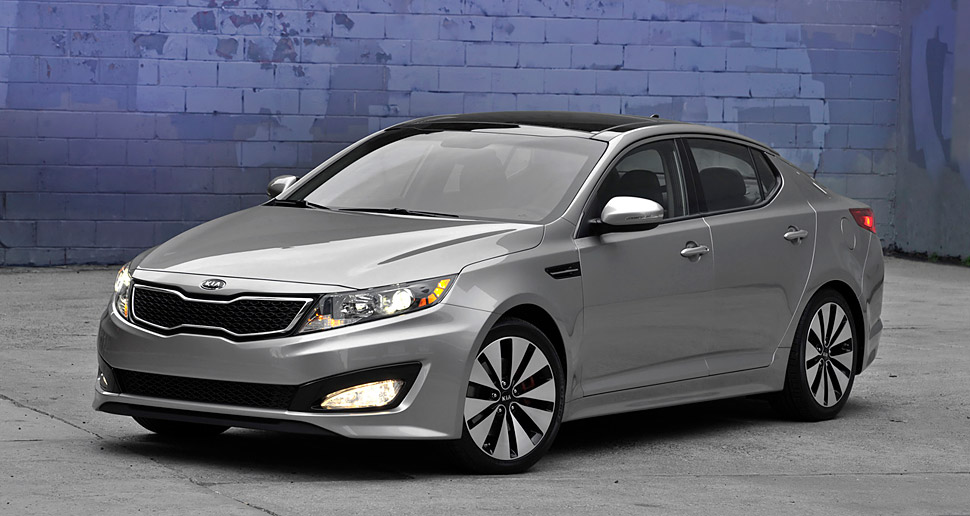 For much of its life, the Kia Optima has been firmly pegged as an also-ran vehicle. Introduced as Kia's first midsize sedan, the first-generation Optima couldn't promise the refinement, documented reliability and assured resale value of its key Japanese competitors. The second-generation Kia Optima followed much the same playbook, though with considerably better results.
For much of its life, the Kia Optima has been firmly pegged as an also-ran vehicle. Introduced as Kia's first midsize sedan, the first-generation Optima couldn't promise the refinement, documented reliability and assured resale value of its key Japanese competitors. The second-generation Kia Optima followed much the same playbook, though with considerably better results.Kia's latest, third-generation Optima is an also-ran no longer. With sleek styling, plenty of standard features, potent engine choices and substantial value, the current Optima is a top pick for a midsize family sedan.
 The current Kia Optima is very similar to the Hyundai Sonata, but to Kia's credit, the Optima has a distinctive European flair to it. From the outside and inside, the Optima looks and feels like a much more expensive car than its humble price tag would suggest. Optimas are available in five trim levels: LX, EX, EX Turbo, SX and Hybrid. Standard equipment on the LX includes full power accessories, air-conditioning, a tilt-and-telescoping steering wheel and a stereo with a CD player, satellite radio, an auxiliary audio jack and an iPod/USB audio interface. The EX and Hybrid add a few more features (like alloy wheels, automatic climate control and leather), while the EX Turbo gets a more powerful engine. The SX is also turbocharged but has a sport-tuned suspension. Option highlights include a navigation system, the Uvo voice-activated electronics interface, a premium sound system and heated and ventilated front seats.
The current Kia Optima is very similar to the Hyundai Sonata, but to Kia's credit, the Optima has a distinctive European flair to it. From the outside and inside, the Optima looks and feels like a much more expensive car than its humble price tag would suggest. Optimas are available in five trim levels: LX, EX, EX Turbo, SX and Hybrid. Standard equipment on the LX includes full power accessories, air-conditioning, a tilt-and-telescoping steering wheel and a stereo with a CD player, satellite radio, an auxiliary audio jack and an iPod/USB audio interface. The EX and Hybrid add a few more features (like alloy wheels, automatic climate control and leather), while the EX Turbo gets a more powerful engine. The SX is also turbocharged but has a sport-tuned suspension. Option highlights include a navigation system, the Uvo voice-activated electronics interface, a premium sound system and heated and ventilated front seats. At the end of this generation, the Kia Optima was offered in three trim levels: base, EX and SX. All came with a 175-horsepower 2.4-liter four-cylinder as standard. The EX and SX could be had with a 194-hp 2.7-liter V6. A five-speed manual transmission was standard on the LX. Optional on the LX and standard on the EX and SX was a five-speed automatic transmission. The automatic-equipped LX came reasonably well equipped with air-conditioning, full power accessories, antilock brakes, stability control, front-seat side airbags and full-length side curtain airbags. The EX provided leather upholstery, while the SX came with a sport-tuned suspension. Although the base four-cylinder provided class-competitive acceleration, the Optima's V6 was disappointing. It was significantly smaller and less powerful than other six-cylinders in the class. This Optima was reasonably fun to drive around town and provided a smooth ride quality, though many of its class contemporaries did a better job of isolating occupants from bumps and ruts.
At the end of this generation, the Kia Optima was offered in three trim levels: base, EX and SX. All came with a 175-horsepower 2.4-liter four-cylinder as standard. The EX and SX could be had with a 194-hp 2.7-liter V6. A five-speed manual transmission was standard on the LX. Optional on the LX and standard on the EX and SX was a five-speed automatic transmission. The automatic-equipped LX came reasonably well equipped with air-conditioning, full power accessories, antilock brakes, stability control, front-seat side airbags and full-length side curtain airbags. The EX provided leather upholstery, while the SX came with a sport-tuned suspension. Although the base four-cylinder provided class-competitive acceleration, the Optima's V6 was disappointing. It was significantly smaller and less powerful than other six-cylinders in the class. This Optima was reasonably fun to drive around town and provided a smooth ride quality, though many of its class contemporaries did a better job of isolating occupants from bumps and ruts.